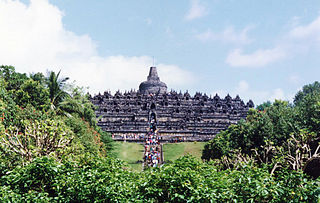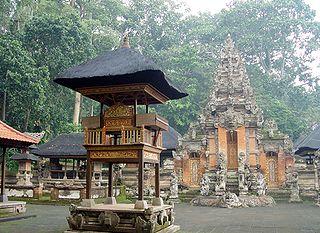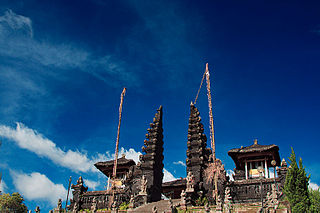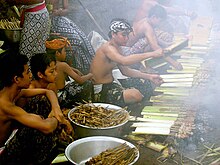
Puja is a worship ritual performed by Hindus, Buddhists and Jains to offer devotional homage and prayer to one or more deities, to host and honour a guest, or to spiritually celebrate an event. It may honour or celebrate the presence of special guests, or their memories after they die. The word pūjā is Sanskrit, and means reverence, honor, homage, adoration and worship. Puja, the loving offering of light, flowers, and water or food to the divine, is the essential ritual of Hinduism. For the worshipper, the divine is visible in the image, and the divinity sees the worshipper. The interaction between human and deity, between human and guru, is called darshan, seeing.

Hinduism in Southeast Asia had a profound impact on the region's cultural development and its history. As the Indic scripts were introduced from India, people of Southeast Asia entered the historical period by producing their earliest inscriptions around the 1st to 5th century CE. Today, Hindus in Southeast Asia are mainly Overseas Indians and Balinese. There are also Javanese and Balamon Cham minority in Cambodia and south central Vietnam who also practice Hinduism.

Balinese Hinduism is the form of Hinduism practised by the majority of the population of Bali. This is particularly associated with the Balinese people residing on the island, and represents a distinct form of Hindu worship incorporating local animism, ancestor worship or Pitru Paksha, and reverence for Buddhist saints or Bodhisattava.

The culture of Indonesia has been shaped by long interaction between original indigenous customs and multiple foreign influences. Indonesia is centrally-located along ancient trading routes between the Far East, South Asia and the Middle East, resulting in many cultural practices being strongly influenced by a multitude of religions, including Buddhism, Christianity, Confucianism, Hinduism, and Islam, all strong in the major trading cities. The result is a complex cultural mixture, often different from the original indigenous cultures.

The Tenggerese people are a sub-ethnic group of Javanese in eastern Java who claim to be the descendants of the Majapahit princes. Their population of roughly 100,000 is centered in 30 villages in the isolated Tengger mountains in the Bromo Tengger Semeru National Park in eastern Java.

The Sasak people live mainly on the island of Lombok, Indonesia, numbering around 3.6 million. They are related to the Balinese in language and in ancestry, although the Sasak are predominantly Muslim while the Balinese are predominantly Hindu. Sasak people who practice pre-Islamic beliefs are also known as Sasak Boda in reference to the name of the Sasak people's original religion, Bodha.

Pendet dance a traditional dance from Bali, Indonesia, in which floral offerings are made to purify the temple or theater as a prelude to ceremonies or other dances. Pendet is typically performed by young girls, carrying bowls of flower petals, handfuls of which are cast into the air at various times in the dance. Pendet can be thought of as a dance of greeting, to welcome the audience and invite spirits to enjoy a performance. It is one of the oldest Balinese dance, although the current form was codified in the 1950s.

Hinduism is the third-largest religion in Indonesia, based on civil registration data in 2022 from Ministry of Home Affairs, is practised by about 1.69% of the total population, and almost 87% of the population in Bali. Hinduism was the dominant religion in the country before the arrival of Islam and is one of the six official religions of Indonesia today. Hinduism came to Indonesia in the 1st-century through Indian traders, sailors, scholars and priests. A syncretic fusion of pre-existing Javanese folk religion, culture and Hindu ideas, that from the 6th-century also synthesized Buddhist ideas as well, evolved as the Indonesian version of Hinduism. These ideas continued to develop during the Srivijaya and Majapahit empires. About 1400 CE, these kingdoms were introduced to Islam from coast-based Muslim traders, and thereafter Hinduism, which was previously the dominant religion in the region, mostly vanished from many of the islands of Indonesia.

Dance in Indonesia reflects the country's diversity of ethnicities and cultures. There are more than 1,300 ethnic groups in Indonesia. Austronesian roots and Melanesian tribal forms are visible, and influences ranging from neighboring Asian and even western styles through colonization. Each ethnic group has its own dances: there are more than 3,000 original dance forms in Indonesia. The old traditions of dance and drama are being preserved in the many dance schools which flourish not only in the courts but also in the modern, government-run or supervised art academies.

The Bali Aga, Baliaga, or Bali Mula are the indigenous people of Bali, predominantly located in the eastern part of the island, in Bangli, Buleleng and Karangasem. They can also be found in north-western and central regions. Bali Aga people who are referred to as Bali Pergunungan are those that are located at Trunyan village. For the Trunyan Bali Aga people, the term Bali Aga is regarded as an insult with an additional meaning of "the mountain people that are fools"; therefore, they prefer the term Bali Mula instead.

Serabi, surabi, or srabi is a traditional Balinese–Javanese snack, similar to a pancake, made of a rice flour-based batter with coconut milk or coconut cream and shredded coconut as an emulsifier. Most traditional serabi tastes sweet, as these pancake-like desserts are usually eaten with kinca, a golden-brown coconut sugar syrup in the Sundanese culinary tradition.

Hyang is a representation of the supreme being, in ancient Java and Bali mythology. The spiritual entity can be either considered divine or ancestral. The reverence for this spiritual entity can be found in the folk religions of Java and Bali, such as the Sunda Wiwitan, Kejawen, Kapitayan, and Gama Tirta. The realm where Hyang resides is called the Kahyangan, which is an Old Javanese term that means "the abode of Hyang", "part of Hyang", or "heaven".

Sunda Wiwitan is a folk religion and ancient beliefs adhered to by the Sundanese in Indonesia.

A Pura is a Balinese Hindu temple, and the place of worship for adherents of Balinese Hinduism in Indonesia. Puras are built following rules, style, guidance, and rituals found in Balinese architecture. Most puras are found on the island of Bali, where Hinduism is the predominant religion; however many puras exist in other parts of Indonesia where significant numbers of Balinese people reside. Mother Temple of Besakih is the most important, largest, and holiest temple in Bali. Many Puras have been built in Bali, leading it to be titled "the Island of a Thousand Puras".

Karangasem Regency is a regency (kabupaten) of the island and province of Bali, Indonesia. It covers the east part of Bali, has an area of 839.54 km2 and had a population of 396,487 at the 2010 Census which rose to 492,402 at the 2020 Census; the official estimate as at mid 2022 was 511,300. Its regency seat is the town of Amlapura. Karangasem was devastated when Mount Agung erupted in 1963, killing 1,900 people. Karangasem was a kingdom before Bali was conquered by the Dutch.

The mythology of Indonesia is very diverse, the Indonesian people consisting of hundreds of ethnic groups, each with their own myths and legends that explain the origin of their people, the tales of their ancestors and the demons or deities in their belief systems. The tendency to syncretize by overlying older traditions with newer foreign ideas has occurred. For example, the older ancestral mythology might be merged with foreign mythology, such as Hindu, Islam, or Christian biblical mythology.

Balinese textiles are reflective of the historical traditions of Bali, Indonesia. Bali has been historically linked to the major courts of Java before the 10th century; and following the defeat of the Majapahit kingdom, many of the Javanese aristocracy fled to Bali and the traditions were continued. Bali therefore may be seen as a repository not only of its own arts but those of Java in the pre-Islamic 15th century. Any attempt to definitively describe Balinese textiles and their use is doomed to be incomplete. The use of textile is a living tradition and so is in constant change. It will also vary from one district to another. For the most part old cloth are not venerated for their age. New is much better. In the tropics cloth rapidly deteriorates and so virtue is generated by replacing them.

Indonesian martial arts includes a variety of fighting systems native to or developed in the archipelago of Indonesia, both the age-old traditional arts, and the more recently developed hybrid combatives. In the Indonesian language the term bela-diri is used to mean martial art, and in essence the Indonesian fighting arts are meant as one's defence against perceived threat and assault. Other than physical training, they often include spiritual aspects to cultivate inner strength, inner peace and higher psychological ends.

Pura Kehen is a Balinese Hindu temple located in Cempaga, Bangli Regency, Bali. The temple is set on the foot of a wooded hill, about 2 kilometres (1.2 mi) north of the town center. Established at least in the 13th-century, Pura Kehen was the royal temple of the Bangli Kingdom, now the Regency of Bangli.





















